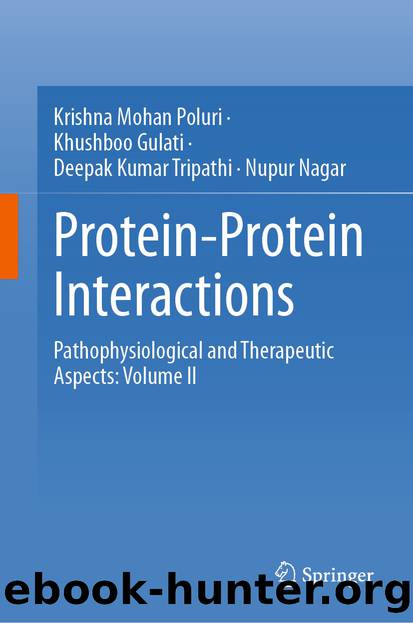Protein-Protein Interactions: Pathophysiological and Therapeutic Aspects: Volume II by Krishna Mohan Poluri & Khushboo Gulati & Deepak Kumar Tripathi & Nupur Nagar

Author:Krishna Mohan Poluri & Khushboo Gulati & Deepak Kumar Tripathi & Nupur Nagar
Language: eng
Format: epub
ISBN: 9789819924233
Publisher: Springer Nature Singapore
5.2.4 Immune Responses Against Infection
The host immune system triggers a complex array of responses to maintain the homeostasis as well as eliminate pathogenic microorganisms and allergens. The activity of foreign agents is under constant surveillance of the immune system and systematically eliminated from the body with no or minimal damage to self-tissues. Due to the presence of a diverse number of pathogens in the environment, the eradication of microbes takes place through several broad as well as detailed selection mechanisms. Together with physical barriers, all immune responses can be categorized into two classes namely, innate immune responses and adaptive immune responses. The innate immunity is the first line of defense mechanisms and acts rapidly on pathogens by recognition of biomolecules (Turvey and Broide 2010). While adaptive immunity acts upon specific microbes, toxins, or allergens. During adaptive immune response, the responding cells proliferate once they encounter an antigen for an effective response. Further, the adaptive response manifests immune memory, i.e., it generates cells which are long-lived and can remain in dormant state for a long time so that any recurrence of infection is eliminated with an effective and much more sensitized feedback. These immune effector mechanisms exhibit self-tolerance while acting upon microbial cells. However, in case of viruses, intracellular bacteria and intracellular parasites, the immune system is obliged to destroy self-tissues which sometimes leads to a severe autoimmune response and damage to the host body. In order to distinguish between infected and healthy cells, various immune response mechanisms have evolved. One of the important mechanisms is the T-cell arm of the immune response. The T-cell acts upon infected cells of host tissue by recognizing and differentiating between foreign and self-antigens present in the lipid bilayer of cells (Chaplin 2010).
Download
This site does not store any files on its server. We only index and link to content provided by other sites. Please contact the content providers to delete copyright contents if any and email us, we'll remove relevant links or contents immediately.
| Administration & Medicine Economics | Allied Health Professions |
| Basic Sciences | Dentistry |
| History | Medical Informatics |
| Medicine | Nursing |
| Pharmacology | Psychology |
| Research | Veterinary Medicine |
Periodization Training for Sports by Tudor Bompa(8173)
Why We Sleep: Unlocking the Power of Sleep and Dreams by Matthew Walker(6620)
Paper Towns by Green John(5092)
The Immortal Life of Henrietta Lacks by Rebecca Skloot(4528)
The Sports Rules Book by Human Kinetics(4299)
Dynamic Alignment Through Imagery by Eric Franklin(4119)
ACSM's Complete Guide to Fitness & Health by ACSM(3991)
Kaplan MCAT Organic Chemistry Review: Created for MCAT 2015 (Kaplan Test Prep) by Kaplan(3940)
Introduction to Kinesiology by Shirl J. Hoffman(3726)
Livewired by David Eagleman(3686)
The Death of the Heart by Elizabeth Bowen(3554)
The River of Consciousness by Oliver Sacks(3543)
Alchemy and Alchemists by C. J. S. Thompson(3452)
Bad Pharma by Ben Goldacre(3358)
Descartes' Error by Antonio Damasio(3232)
The Emperor of All Maladies: A Biography of Cancer by Siddhartha Mukherjee(3070)
The Gene: An Intimate History by Siddhartha Mukherjee(3050)
The Fate of Rome: Climate, Disease, and the End of an Empire (The Princeton History of the Ancient World) by Kyle Harper(3007)
Kaplan MCAT Behavioral Sciences Review: Created for MCAT 2015 (Kaplan Test Prep) by Kaplan(2941)
